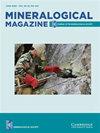Ferric iron in chrome-bearing spinels: implications for microprobe correction procedures
IF 1.4
3区 地球科学
Q2 MINERALOGY
引用次数: 0
Abstract
Abstract We investigated the compositions of a suite of 361 chrome-bearing spinels from spinel peridotites, ophiolitic mantle chromitites and from layered igneous intrusions in which the Fe 2+ /Fe 3+ ratio has been determined by Mössbauer spectroscopy. We explore the crystal-chemical controls on the distribution of Fe 3+ and on mineral stoichiometry with regard to electron-probe correction procedures for estimating Fe 3+ in spinel. We find that chrome-bearing spinels can be subdivided into three groups: a Cr–Al-rich group; a high-Fe group; and a highly oxidised group. Spinels of the Cr–Al group are found in spinel peridotites and ophiolitic mantle chromitites. They are normal spinels with a low Fe 3+ content and compositions that are close to stoichiometric. Spinels in the high-Fe group are found in layered igneous intrusions. They are also normal spinels which have higher concentrations of Fe 3+ on the octahedrally coordinated site than is found for the Cr–Al group. Stoichiometric calculations tend to overestimate the Fe 3+ content and their compositions do not conform to the MgO–cr# correlation found in the Cr–Al group. Spinels in the highly oxidised group are found in layered intrusions and ophiolitic mantle chromitites. They have (Fe 3+ /ΣFe) Möss > 0.4 and high Cr (cr# > 0.5), but relatively low Fe 2+ (fe# 0.24–0.56). Stoichiometric calculations tend to underestimate the Fe 3+ content. They represent normal spinels in which tetrahedrally coordinated Fe 2+ has been oxidised to Fe 3+ . Our data show that spinels with greater Cr and Fe are sufficiently different in their crystal chemistry from the aluminous spinels to indicate that the EPMA correction procedures developed for Fe 3+ in aluminous spinels on the basis of the Cr/Al ratio, and used in oxy-thermobarometry, are inappropriate for Cr-rich and Fe-rich compositions.含铬尖晶石中的铁:微探针校正程序的意义
摘要本文研究了尖晶石橄榄岩、蛇绿质地幔铬铁矿和层状火成岩侵入体中361颗含铬尖晶石的组成,并用Mössbauer光谱法测定了其中的fe2 + / fe3 +比值。我们探讨了晶体化学对铁3+分布的控制,以及关于尖晶石中铁3+的电子探针校正程序的矿物化学计量学。我们发现含铬尖晶石可分为三组:富cr - al组;高铁基团;一个高度氧化的基团。Cr-Al类尖晶石见于尖晶石橄榄岩和蛇绿质地幔铬铁矿中。它们是正常尖晶石,fe3 +含量低,组成接近化学计量。高铁组尖晶石见于层状火成岩侵入体中。它们也是正常尖晶石,在八面体配位位点上的fe3 +浓度高于Cr-Al基团。化学计量学计算倾向于高估fe3 +含量,其组成不符合Cr-Al组中MgO-cr #的相关性。高氧化组尖晶石见于层状侵入体和蛇绿质地幔铬铁矿中。它们有(Fe 3+ /ΣFe) Möss >Cr (Cr # >0.5),但Fe 2+相对较低(Fe # 0.24-0.56)。化学计量计算往往低估了铁3+的含量。它们代表正常尖晶石,其中四面体配位的fe2 +被氧化为fe3 +。我们的数据表明,具有较大Cr和Fe的尖晶石在晶体化学上与铝尖晶石有足够的不同,这表明基于Cr/Al比开发的铝尖晶石中Fe 3+的EPMA校正程序,并用于氧热压测量,不适合富Cr和富Fe成分。
本文章由计算机程序翻译,如有差异,请以英文原文为准。
求助全文
约1分钟内获得全文
求助全文
来源期刊

Mineralogical Magazine
地学-矿物学
CiteScore
4.00
自引率
25.90%
发文量
104
审稿时长
6-12 weeks
期刊介绍:
Mineralogical Magazine is an international journal of mineral sciences which covers the fields of mineralogy, crystallography, geochemistry, petrology, environmental geology and economic geology. The journal has been published continuously since the founding of the Mineralogical Society of Great Britain and Ireland in 1876 and is a leading journal in its field.
 求助内容:
求助内容: 应助结果提醒方式:
应助结果提醒方式:


